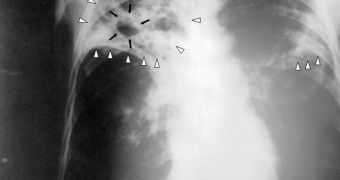It's now official – tuberculosis (TB) is one of the oldest diseases on Earth and one that has "coexisted" with humans for the better part of the last 9,000 years. Digs at Alit-Yam, off the coast of Egypt, revealed skeletal remains of a mother and her baby. Their bones exhibited markings similar to those left behind by TB, so scientists decided to run a DNA scan on them. The results revealed the presence of Mycobacterium tuberculosis in their system, thus putting an end to theories stating that the human strain of TB evolved from cattle TB over 6,000 years ago.
This new discovery provides the missing link between two strains of tuberculosis, as researchers had no actual evidence that the bacteria evolved from cattle and infected humans or vice versa. The fact that Alit-Yam is one of the first Neolithic settlements evidenced to have domesticated cattle further goes to show that the bacteria infected humans first and then mutated into its bovine form. Several more skeletons found at the dig site exhibited traces of bacterial cell wall lipids, which have been directly linked to the presence of TB after DNA analysis.
According to Dr. Helen Donoghue, of the Center for Infectious Diseases & International Health at University College London, the human strain of TB was present in the settlement even before dairying practices took hold in proto-communities. "The presence of large numbers of animal bones shows that animals were an important food source, and this probably led to an increase in the human population that helped the TB to be maintained and spread," she added.
Having discovered the first hosts of the TB bacteria, biologists now hope to be able to sequence the bacterial DNA, in the hope that they would find out exactly how it mutated over the thousands of years it lived in humans. Already, several strand portions have been identified in samples collected from the bones in Egypt, which are not present in today's TB strains. This could mean that changes in human physiology may also trigger alternate responses in bacterial morphology. Scientists continue their research, with the big prize being finding a way of ridding humanity of this terrible disease.

 14 DAY TRIAL //
14 DAY TRIAL //